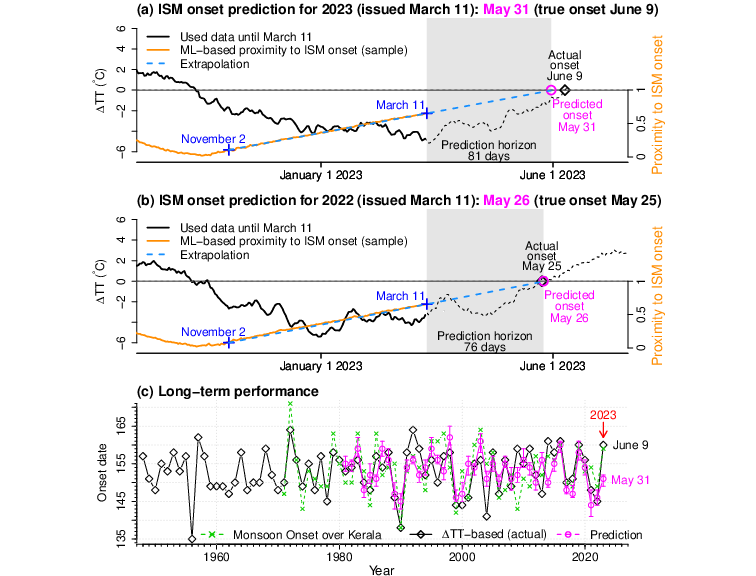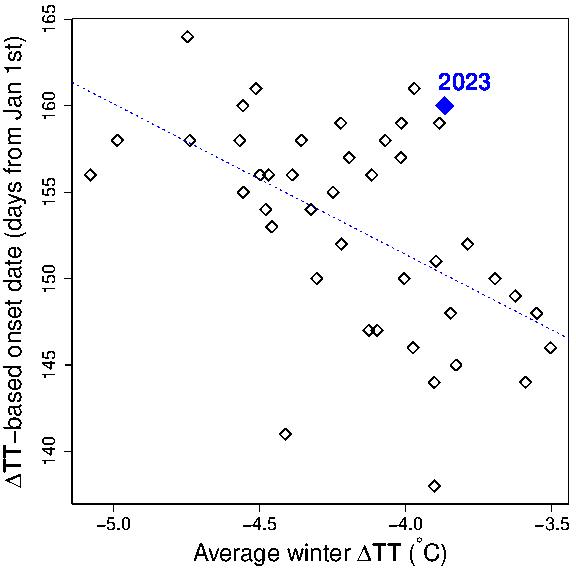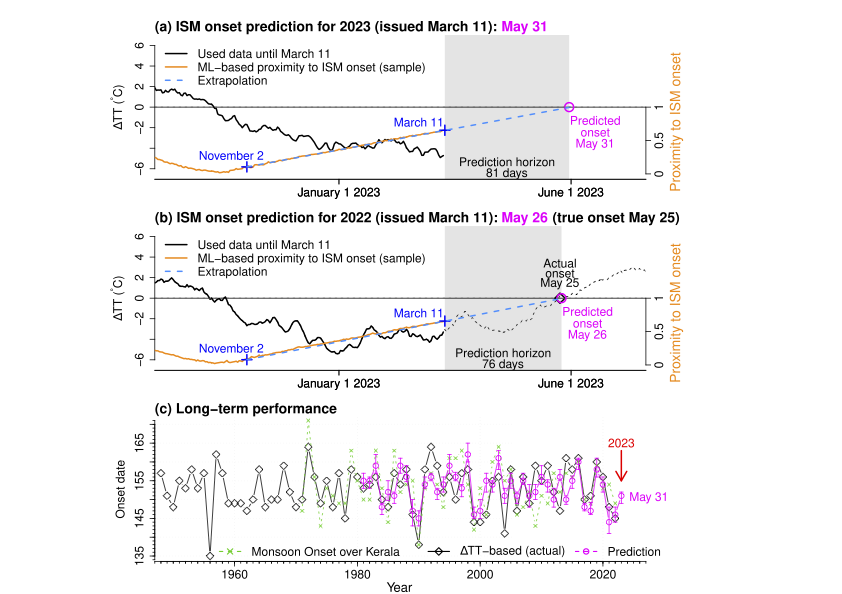Seasonal Prediction of Indian Summer Monsoon Onset with Neural Networks: Result for 2023
For 2023, by March 11th we predicted the ISM onset to take place on May 31st, with an interquartile range from May 29th to June 1st. However, the ΔTT-based ISM onset took place on June 9th (Fig. A). The 9-day prediction error in this year is large (while still within the 2σ-range of the past prediction errors (2x4.8=9.6 days). The ΔTT-based ISM onset date is mildly correlated with the winter average ΔTT (r=-0.54), but the year 2023 is an outlier in this regard (see Fig. B).
The India Meteorological Department (IMD) predicted the Monsoon onset over Kerala for June 4th (4 days) and announced the actual onset of the Monsoon on June 8th (one week later than the average onset on June 1st). The IMD noted that the Arabian sea cyclonic storm Biparjoy caused the delayed Monsoon onset by drawing the moisture-laden south-westerlies away from the Indian coast.
Figure A: (a) Prediction of the Indian Summer Monsoon onset date for 2023 (May 31st (median), with an interquartile range from May 29th to June 1st). The actual onset is June 9th. (b) The same but for 2022. (c) Long-term prediction performance since 1981.
Figure B: Correlation between ΔTT-based onset date and the average winter ΔTT (r=-0.54). The 2023 case is an outlier, leading to our poor prediction for 2023.
We have recently introduced a method based on Neural networks to predict the Indian Summer Monsoon (ISM) onset with a seasonal-scale forecast horizon of around 80 days. From 1981 to 2022, the method hindcasts the ISM onset dates with an accuracy of +/- 4.8 days (RMSE).
ISM onset prediction for 2023
For 2023, with data until March 11 we predict the ISM onset to take place on May 31, with an interquartile range from May 29 to June 1.
Fig. 1. (a) Prediction of the Indian Summer Monsoon onset date for 2023 (May 31 (median), with an interquartile range from May 29 to June 1). (b) The same but for 2022. (c) Long-term prediction performance since 1981.
ISM onset prediction for 2022
For 2022, with data until March 11 we predicted the ISM onset to occur on May 26, 2022 with interquartile range May 24 to May 28, 2022. The true onset occurred on May 25, 2022.
Details of the method
The Indian Summer Monsoon (ISM) sets in at the Southern tip of India, typically around the beginning of June. The prediction of the ISM onset date is crucial for effective agricultural planning and general water-resource management in India.
The meridional gradient of the tropospheric temperature over the southern Eurasian region (∆TT) is a widely-used index for an objective definition of the ISM onset date [Xavier et al., 2007]. The onset date is defined as the day of year at which ∆TT changes from negative to positive (see black lines in Fig. 1a,b). The ∆TT-based ISM onset date is strongly correlated with the Monsoon onset over Kerala (MOK) (Fig. 1c, green). The MOK is declared by the Indian Meteorological Department and forecasted at the end of April and in the middle of May.
Mitsui and Boers (2021) proposed a neural-network-based prediction method (Fig. 2, left) for the ∆TT-based ISM onset date, with a seasonal-scale lead time (around 83 days). We thus extend the forecast time considerably to seasonal time scales. So far, we have succeeded in hindcasting the onset dates during 1981-2022 with an accuracy of +/- 4.8 days (RMSE) and correlation coefficient of 0.6 (Fig. 1c).
Fig. 2. (Left) Schematic of our method. We construct recurrent neural networks that approximate proximity to the onset of Indian Summer Monsoon (Mitsui and Boers, 2021). (Right) Empirical negative correlation between the average winter ∆TT (the first 70 days of year) and the actual onset date (R=-0.54). The point for 2023 alone is based on the predicted onset date.
Our neural-network prediction is consistent with the negative correlation between the average winter ∆TT and the onset dates (Fig. 2, right). In 2022, for example, a high winter ∆TT led to a relatively earlier onset (May 25, see Fig. 1b). Also in 2023, the winter ∆TT is relatively high but still has a downward trend at least until March 11 (Fig. 1a). This tendency may prevent an ISM onset as early as in 2022.
Article:
T. Mitsui and N. Boers: Seasonal prediction of Indian summer monsoon onset with echo state networks, Environmental Research Letters 16 (2021)









